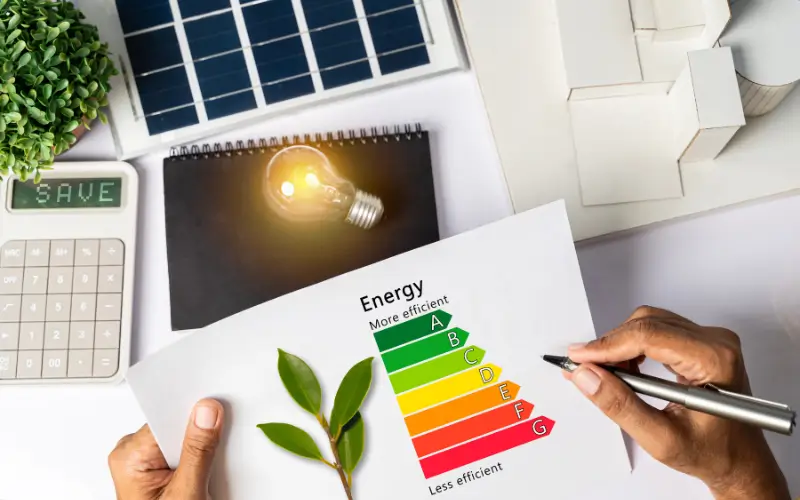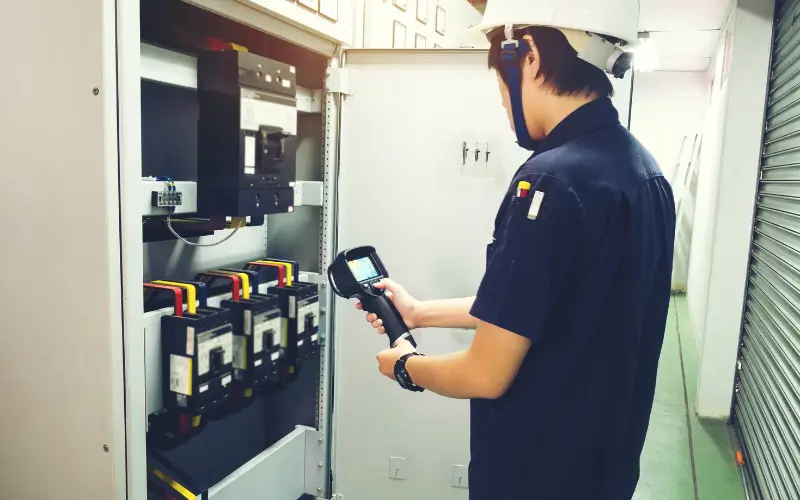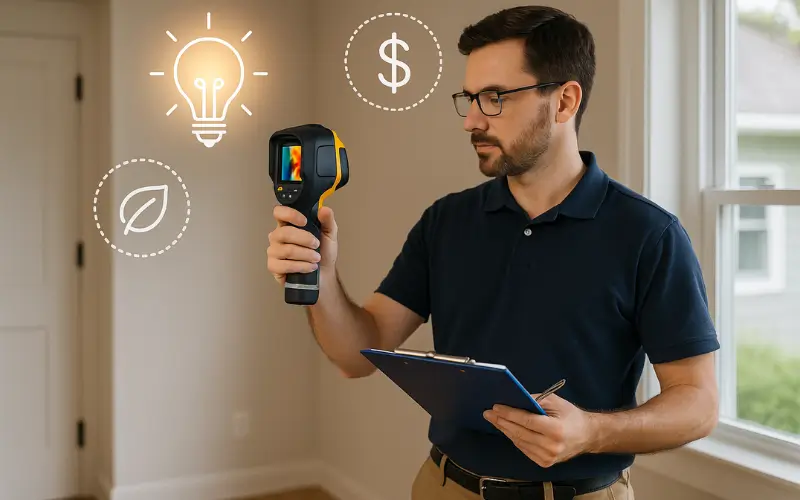Are your utility bills creeping higher month by month? Or maybe you just want to do your part for the planet without hiring a professional auditor? Then a DIY mini energy audit might be the perfect starting point.
Conducting a DIY Mini Energy Audit
A DIY energy audit gives you the tools to understand where your home is wasting energy—and how to fix it. While it doesn’t replace a professional inspection, this hands-on approach can uncover surprisingly simple and affordable improvements you can make today.
Whether you’re trying to cut costs, improve comfort, or reduce your carbon footprint, this guide walks you through the exact steps to audit your home’s energy use—no special tools or technical knowledge required.
In this guide, you’ll learn:
- How to check for energy leaks
- Where insulation might be lacking
- How much energy your appliances are drawing
- What quick fixes can save you real money
What Is a DIY Mini Energy Audit?
A DIY mini energy audit is a simplified version of a professional home energy assessment that you can perform on your own. Its purpose is to help you identify areas in your home where energy is being wasted, so you can make small but effective improvements—without hiring an expert or buying expensive tools.
Think of it as a practical checklist that helps you:
- Detect drafts and air leaks around windows, doors, outlets, and vents
- Review insulation levels in accessible areas like the attic or basement
- Examine heating, cooling, and hot water systems
- Track appliance energy usage and lighting efficiency
Why “Mini”?
Unlike a full audit performed by certified professionals (which may involve thermal imaging, blower door tests, or combustion analysis), a mini audit focuses on the basics you can inspect and fix yourself—in just a few hours.
Despite being “mini,” it still packs a punch. Studies suggest that identifying and fixing common issues like drafts and outdated lighting can reduce home energy use by 10–30% annually.
When Should You Do One?
The ideal times to conduct a DIY audit are:
- Spring or fall – mild temperatures make it easier to spot insulation and HVAC issues
- Before seasonal weather changes – prepare for heating in winter or cooling in summer
- Before moving into a new home or after renovations – check for overlooked inefficiencies
Who Should Try It?
- Homeowners looking to cut energy bills
- Renters wanting to improve comfort (with landlord approval)
- Sustainability-conscious individuals
- DIYers who enjoy hands-on projects
In short, a DIY mini energy audit is a low-cost, high-impact way to gain visibility into your home’s energy performance and take practical steps toward improvement.
Why Do a DIY Energy Audit?
If you’ve ever felt a chilly draft near a window in winter, or wondered why your electricity bill suddenly spiked, you’ve already had a hint that your home may be wasting energy. A DIY energy audit helps you identify those issues systematically—and empowers you to fix them.
Here’s why taking the time to do one can pay off big:
1. Save Money on Utility Bills
Energy waste costs money—often more than you realize. Air leaks, poor insulation, inefficient lighting, and aging appliances all contribute to unnecessary power use.
2. Improve Home Comfort
Drafty rooms, uneven temperatures, and cold floors aren’t just annoying—they’re signs that your home isn’t sealing or distributing heat/cooling efficiently.
- A mini audit helps you:
- Identify cold or hot spots
- Balance airflow and insulation
- Reduce noise from outside
3. Reduce Your Carbon Footprint
Reducing energy waste doesn’t just benefit your wallet—it’s one of the easiest ways to lower your environmental impact. Whether you’re using gas or electricity, wasted energy means more fossil fuel burned upstream.
Even small steps like switching to LED bulbs or sealing drafty doors help reduce emissions.
4. Gain Insight and Control
Understanding where energy goes in your home gives you control over it. You’ll stop guessing and start making informed decisions—whether it’s upgrading insulation, replacing an old appliance, or simply changing usage habits.
5. It’s Easy, Free, and Educational
Best of all, a DIY mini energy audit is something you can do:
- In just a couple of hours
- With everyday items (like a flashlight, candle, or notepad)
- Without hiring a pro
- It’s a hands-on learning experience—and many homeowners find it eye-opening and even fun.
Preparing for Your Audit
Before you jump into inspecting every corner of your home, take a few minutes to prepare properly. A little planning will make your audit smoother, faster, and much more effective.
Tools and Supplies You’ll Need
Most items you’ll use are either already in your home or inexpensive to buy. Here’s a checklist of essentials:
| Tool | Purpose |
| 🔦 Flashlight | To inspect attics, basements, or crawlspaces |
| 🕯️ Incense stick or candle | To detect drafts or air movement |
| 📒 Notebook or mobile note app | To record findings room-by-room |
| 📏 Tape measure | To measure insulation depth or window gaps |
| 🧤 Gloves | For safe inspection in dusty or insulated areas |
| 🪟 Weatherstripping & caulk | For sealing air leaks you find immediately |
| 📷 Smartphone camera | To photograph problem areas or track progress |
| 💡 LED bulbs | To replace inefficient lighting on the spot |
Optional tools (if available):
- Non-contact thermometer or infrared temp gun
- Smart energy monitor or plug-in meter (like Kill-A-Watt)
Safety Considerations
Your safety comes first. Here are some simple precautions:
- Electrical Safety: Never open electrical panels or tamper with wiring. Turn off breakers before checking outlets or fixtures.
- Ladder Safety: Always use a sturdy ladder and have someone nearby when inspecting attics or high places.
- Insulation Awareness: If your home was built before 1990, be cautious of asbestos in old insulation. Avoid disturbing it and consult a professional if you suspect it.
- Ventilation: When using candles or incense for draft detection, ensure good airflow—especially around gas appliances.
Choose the Right Time
Plan your audit on a calm, dry day, ideally when there’s a noticeable temperature difference between inside and outside. This makes it easier to detect drafts and insulation gaps.
Create an Audit Template
Set up a simple checklist or spreadsheet with the following columns:
- Room/Area
- Issue Found
- Fix Needed
- Priority (Low/Medium/High)
- Estimated Cost
This helps keep your audit organized—and makes it easier to track which fixes you’ve completed later on.
Audit Checklist — Systematic Walkthrough
This is where your DIY mini energy audit becomes hands-on. You’ll go room by room and system by system, checking for common sources of energy waste. Keep your notepad or checklist nearby and mark findings as you go.
1. Review Your Utility Bills
Start with your past 12 months of energy bills—electricity, gas, or other utilities. You’re looking for:
- Seasonal spikes (e.g., big jump in winter = heating inefficiencies)
- High base loads (indicating energy-hungry appliances running 24/7)
- Unexplained increases in usage
Action Tips:
- Calculate your average monthly usage
- Note peak usage months and research why they may be high
- Consider downloading your utility’s detailed usage data if available (some offer hourly or daily breakdowns)
2. Locate and Seal Air Leaks
Air leaks are one of the biggest culprits in home energy waste. Common problem areas:
- Windows & doors (especially older wooden frames)
- Electrical outlets & switch plates on exterior walls
- Baseboards and trim
- Attic hatches
- Plumbing/electrical penetrations
- Dryer vent connections
Fixes:
- Caulk small cracks around windows, trim, or baseboards
- Apply weatherstripping to doors
- Use foam gaskets behind outlet/switch covers
- Seal around pipes with expanding spray foam
3. Inspect Insulation Levels
Proper insulation helps maintain indoor temperature and reduces the load on your heating and cooling systems. Focus on:
- Attic: Should have 10–14 inches of insulation depending on type
- Exterior walls: Difficult to inspect, but check outlets (pull off cover—if there’s no insulation behind, your walls may be under-insulated)
- Basement & crawlspaces: Cold floors above? You may need insulation below
Fixes:
- Add insulation batts in the attic or blown-in cellulose (DIY kits available)
- Install attic door insulation tents
- Seal attic floor penetrations before insulating
4. Examine Heating, Cooling & Hot Water Systems
Your HVAC and water heating systems account for the largest share of energy use. Key items to check:
- Furnace or AC filters – dirty filters restrict airflow and reduce efficiency
- Ductwork – check for visible gaps or loose connections
- Water heater – set to 120–130°F and check for insulation on tank and pipes
Fixes:
- Replace or clean HVAC filters monthly
- Seal duct joints with mastic or foil tape (not cloth duct tape)
- Wrap water heater in an insulating blanket (unless it’s a high-efficiency model)
- Insulate exposed hot water pipes
5. Audit Appliances, Lighting & Phantom Loads
Check which appliances are running often, even when not in use. These include:
- Coffee makers
- Microwaves
- Modems/routers
- TVs and gaming systems
- Chargers and printers
- Also assess lighting:
- Are you still using incandescent or CFL bulbs?
- Do lights stay on in unused rooms?
Fixes:
- Replace old bulbs with LEDs
- Use motion sensors or smart timers for outdoor or hallway lighting
- Unplug or use smart power strips for electronics to eliminate phantom loads
Post-Audit Actions & Prioritization
Now that you’ve completed your walkthrough and gathered findings, it’s time to translate observations into actions. This step is critical—it turns your DIY audit into measurable energy savings.
1. Organize and Analyze Your Findings
Use your audit checklist or notes to categorize what you found. Group items by:
- Severity of impact (e.g., major air leaks vs. minor light usage)
- Cost to fix (free, low-cost, or requires investment)
- Ease of implementation (quick DIY vs. may need a pro)
Example Table:
| Issue Found | Area | Fix Needed | Priority | Cost | Type |
| Drafty window in bedroom | Window | Caulk & film | High | Low | DIY |
| Old water heater, no wrap | Utility room | Add insulation | Medium | Low | DIY |
| No attic insulation | Attic | Add blown-in ins. | High | High | Pro/DIY |
| 6 incandescent bulbs | Living Room | Replace w/ LED | High | Low | DIY |
2. Prioritize by Impact and Payback
Start with low-cost, high-impact fixes. These often offer the best return on investment and can be done in a single afternoon:
- Caulking and weatherstripping
- LED lighting upgrades
- Thermostat adjustments
- Unplugging phantom load devices
- Then move on to medium investments, like:
- Adding pipe insulation
- Wrapping water heaters
- Sealing ductwork
Higher-cost upgrades like attic insulation or replacing windows should still be noted—but may require planning, budget, or outside help.
3. When to Call a Professional
While a mini audit covers a lot, some problems may warrant a pro’s touch:
- Persistent high bills after DIY fixes
- Suspected duct leaks behind walls
- Old HVAC systems needing diagnostic tools
- Blower door or infrared imaging tests (for full insulation and leak mapping)
A professional energy audit typically costs $150–$500, but many utilities offer rebates or even free audits—check with yours.
4. Create an Action Timeline
Don’t feel pressure to fix everything at once. Break improvements into:
- Quick wins (this week)
- Medium fixes (this month)
- Bigger projects (this year)
Set reminders and revisit your list monthly to track progress.
By prioritizing efficiently, you’ll stretch your efforts further and see real energy—and cost—savings over time.
Sample Mini-Audit Plan (Quick Version)
Don’t have a full afternoon? Use this fast-track plan to complete a DIY energy audit in about 1–2 hours.
This is perfect for busy homeowners, renters, or first-timers who want quick wins without diving into complex diagnostics.
Time-Efficient DIY Energy Audit: Step-by-Step
1. Gather Essentials (10 minutes)
Prepare your basic toolkit:
- Flashlight
- Notebook or checklist
- Candle or incense stick
- Caulk/weatherstripping (if planning immediate fixes)
- Tape measure
2. Check Utility Usage Patterns (10 minutes)
- Compare electricity and gas bills over the past 12 months
- Highlight months with highest consumption
- Note seasonal trends or unusual spikes
3. Draft Check (20 minutes)
Walk through:
- Doors and windows
- Outlets on exterior walls
- Baseboards and attic hatches
4. Lighting & Phantom Loads (10 minutes)
- Count incandescent or CFL bulbs — make a replacement list
- Look for electronics plugged in but not in use (TVs, printers, routers)
- Plug them into smart power strips or unplug when idle
5. Heating & Water System Checks (15 minutes)
- Check HVAC filter: replace if dusty
- Verify water heater is set to 120–130°F
- Feel hot water pipes — are they warm and uninsulated?
6. Quick Visual Insulation Scan (15 minutes)
- Peek into attic: is insulation deep and evenly spread?
- Touch exterior walls and note temperature difference
- Feel floor temperature above crawlspaces or basements
Mini-Audit Summary Sheet (Sample Format)
| Area | Issue Found | Quick Fix Done | Notes |
| Bedroom Window | Strong draft | ✔ Caulked | Retest next week |
| Living Room | 3 incandescents | ✔ Replaced | |
| HVAC Filter | Dirty | ✔ Replaced | Date: [insert] |
| Water Heater | Temp = 140°F | ✔ Lowered to 125°F | |
| Modem & TV | Always on | ✔ Smart strip |
This quick plan allows you to cover the highest impact areas of your home in just one focused session. You can then expand into deeper audit tasks whenever time allows.
Tools to Monitor Energy Moving Forward
A successful DIY mini energy audit doesn’t end after you seal a few drafts or swap lightbulbs. The real value comes when you continue to track, measure, and adjust your energy use over time.
Today’s smart tools make it easier than ever to monitor energy consumption and stay on top of efficiency—without needing to be an expert.
1. Smart Plugs & Energy Monitors
These small devices plug into your wall outlets and track energy use of anything connected to them—great for identifying phantom loads and energy-hungry appliances.
Popular options:
- TP-Link Kasa Smart Plug – Tracks real-time energy use and can be scheduled
- Emporia Smart Plug – Affordable and app-connected for multi-device tracking
- Kill A Watt Monitor – A plug-in meter that gives you wattage, cost, and time stats
Use it for: TVs, computers, mini-fridges, chargers, printers, and entertainment systems.
2. Smart Thermostats
A smart thermostat like Google Nest, Ecobee, or Honeywell Home learns your habits and optimizes heating/cooling schedules automatically.
Benefits:
- Auto-adjusts temperature when you’re away
- Can reduce HVAC energy use by 10–15% annually
- Tracks your usage history and suggests improvements
Bonus: Some utility companies offer rebates for smart thermostats.
3. Whole-Home Energy Monitors
Want to go deeper? Devices like Sense Energy Monitor or Emporia Vue connect to your electric panel and give you real-time data on your entire home’s energy use.
You’ll be able to:
- See which systems/appliances are drawing the most power
- Set daily/weekly energy goals
- Identify spikes or abnormal usage
These tools are ideal if you’re committed to long-term energy savings or planning future upgrades.
4. Utility Company Dashboards
Many modern utility providers now offer online portals or apps with features like:
- Hourly or daily usage reports
- Bill projection tools
- Peak hour alerts
- Comparison with similar homes in your area
5. Energy-Saving Apps & Dashboards
There are apps that sync with smart devices or operate independently to help you stay accountable:
- JouleBug – Tracks eco-friendly actions and rewards good habits
- Green Outlet – Calculates energy use and carbon footprint
- EnergyHub – Controls connected thermostats and devices for smarter use
Routine Monitoring Tips
- Track bills monthly: Set a reminder to review your usage
- Log quick fixes: Create a “home efficiency log” with completed improvements and dates
- Set savings goals: For example, reduce energy use by 15% this quarter
By integrating these tools, your DIY energy audit evolves into a long-term energy management system—giving you real control and real savings.
Cost & Savings Estimates
Understanding the financial impact of your DIY mini energy audit helps you prioritize fixes and stay motivated. Here’s a breakdown of typical costs for common improvements — along with the average annual savings you can expect.
1. Air Sealing & Weatherstripping
| Item | Estimated Cost | Average Annual Savings |
| Caulk tube | $5–$10 | $10–$30 per area sealed |
| Weatherstripping | $5–$20 per door/window | $20–$50 per door/window |
| Foam gaskets (outlet covers) | $5 for 10 pack | $5–$10 per outlet |
Why it saves: Prevents warm or cool air from escaping, reducing heating/cooling demand.
2. Insulation Upgrades
| Item | Estimated Cost | Average Annual Savings |
| Attic insulation (DIY kit) | $1.50–$3.00 per sq ft | $100–$300 depending on home size |
| Pipe insulation (foam wrap) | $1–$2 per 6 ft section | $10–$20 per year |
Why it saves: Maintains consistent indoor temperature and reduces HVAC run time.
3. Lighting
| Item | Estimated Cost | Average Annual Savings |
| LED bulb (per bulb) | $2–$5 | $5–$10 per bulb replaced |
| Smart power strip | $15–$40 | $10–$30 per year by reducing phantom loads |
Why it saves: LEDs use 75–80% less energy than incandescent bulbs; smart strips cut standby power waste.
4. Heating & Cooling
| Item | Estimated Cost | Average Annual Savings |
| HVAC filter replacement | $5–$20 (3-month supply) | $20–$50 by improving airflow |
| Water heater blanket | $20–$30 | $10–$45 depending on insulation level |
Why it saves: Improves system efficiency and reduces wasted energy from heat loss.
5. Appliances & Electronics
| Item | Estimated Cost | Average Annual Savings |
| Energy-efficient appliances | $200+ (varies) | $50–$200+ depending on model |
| Smart plugs/monitors | $20–$50 each | $10–$40 by tracking and managing usage |
Summary
- Total DIY investment: Often less than $100 for multiple fixes.
- Typical payback: Many homeowners see full ROI within the first year.
- Energy savings: Up to 30% reduction on utility bills is achievable with persistent effort.
By combining low-cost fixes with strategic improvements, your DIY mini energy audit can translate into meaningful savings—both on your bills and your environmental footprint.
Conclusion
Conducting a DIY mini energy audit is a powerful and affordable way to take control of your home’s energy use. By systematically checking for drafts, inspecting insulation, assessing appliances, and making simple fixes, you can reduce energy waste, lower your utility bills, and improve comfort—without waiting for a professional.
Remember, the key is to start small, prioritize the biggest wins, and build momentum over time. With the right tools and a step-by-step approach, energy savings are within everyone’s reach.
Frequently Asked Questions (FAQs)
Q1: What is the difference between a mini DIY energy audit and a professional energy audit?
A: A mini audit is a basic home inspection you do yourself focusing on common issues like air leaks and insulation. A professional audit uses specialized equipment like blower doors and infrared cameras for a detailed analysis.
Q2: How often should I conduct a DIY energy audit?
A: Ideally, once a year—especially before heating and cooling seasons. Regular audits help catch new issues early.
Q3: Can I detect air leaks without special tools?
A: Yes! Using a candle or incense stick and feeling for drafts with your hand can reveal many leaks.
Q4: How much can I save with a DIY mini energy audit?
A: Savings vary, but many homeowners reduce their energy bills by 10–30% by addressing common inefficiencies.
Q5: What areas should I tackle first for the most impact?
A: Start with sealing air leaks, upgrading lighting to LEDs, and maintaining HVAC filters—these offer the quickest payback.




